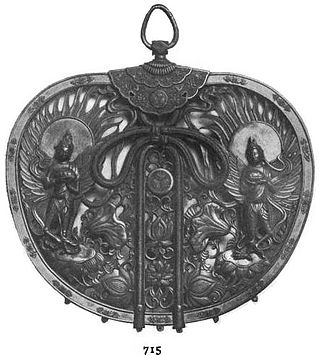Top Qs
Timeline
Chat
Perspective
Keman
Ornament of Buddha From Wikipedia, the free encyclopedia
Remove ads
Keman (華鬘(けまん)) (Japanese phoneticization from the Sanskrit kusumamālā "Garland of Flowers"[2]), is a Buddhist ritual decoration, placed hanging on the beam of the inner sanctuary before the enshrined Buddha, in the main hall of the temple.[3]

As its Sanskrit name suggests, it originated as a term for fresh flowers strung together and tied in a loop,[2] but became a name for such implements as used to pay respect to the dead (hotoke),[2] and eventually signified ritual implements ornamenting the inner sanctuary (naijin (内陣)), corresponding to the chancel of a church.[2]
They are typically made from gilt bronze in the shape of a round fan (uchiwa).[3] Other materials used for making it are oxhide,[2] wooden boards,[2][3] or threads.[2][3] The design may feature karyobinga (harpy-like beings), or use foliage scroll-work (karakusa) combined with the hōsōge (imaginary peony-like floral pattern), lotus, or peony.[2] A well-known example is the keman from the Golden Hall of Chūson-ji in Northern Japan, designated National Treasure.
Remove ads
Popular culture
- keman-sō (ケマンソウ) is the Japanese name for the wildflower "Lamprocapnos spectabilis" (also known under genus Dicentra; common name "bleeding heart"), so named because the flower's shape resembles the keman ornament.
See also
References
Wikiwand - on
Seamless Wikipedia browsing. On steroids.
Remove ads
